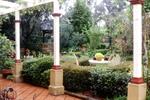
Learn to Create Different Garden Styles
- Design different types of gardens: formal and informal
- Learn to design oriental gardens, Mediterranean gardens, eclectic gardens, and other types of gardens
- Expand your garden design skills, further your career as a landscape designer
"This is the first correspondence course I have done and I have thoroughly enjoyed it and I just wanted to say a big THANK YOU. I appreciate everyone's effort in such a professionally-run organisation with seamless administration. The office staff's happy can-do attitude, their fast responses to all queries, tutor Shane Gould's quick turnaround in assignment marking and his supportive and motivational feedback and last but not least, the sound subject guides. Most importantly I hope my thanks and appreciation can be communicated to all the staff who have supported me long the way of my learning! I work full time and study on the weekend but really don't stop thinking about what gardening solution I need in order to answer my assignments every day of the week. Thank you for such a great learning experience and I cant wait to start the second half of my course!!"
- Skye
Lesson Structure
There are 10 lessons in this course:
-
Creating the Mood
-
Historic Gardens
-
Formal Gardens
-
Oriental Gardens
-
Middle Eastern and Spanish Style
-
Mediterranean Gardens
-
Coastal Gardens
-
Modern Gardens
-
Eclectic Gardens
-
Other Styles
Aims
-
Explain the use of colour, light, shade, temperature, water, foliage and other elements in establishing the mood of a garden.
-
Describe gardens from different places and periods in history; and in doing so explain how to renovate and/or recreate gardens that reflect the style of different historic periods.
-
Apply the principles, design features and elements that make up a formal garden.
-
Discuss cultural and historical traditions that contributed to the development and style of the oriental garden.
-
Discuss cultural and historical traditions that have contributed to the development and style of the Middle Eastern and Spanish garden.
-
Discuss the historic, climatic and cultural influences which have contributed to the style of Mediterranean gardens.
-
Discuss design styles of coastal gardens
-
Explain the limitations and potential of coastal sites when preparing a landscape design.
-
Discuss contemporary garden design styles and possible future trends in garden design.
-
Identify the range of diversity possible in garden design.
-
Identify characteristics of different garden styles including eclectic, dryland, permaculture, rainforest and tropical garden styles.
-
Design different styles of gardens.
What You Will Do
-
Visit different gardens to assess the mood of each garden. Take time to observe each garden and try to identify the different elements that contribute to the garden mood.
-
Observe how colour has been used in the three different gardens. Observe the colours of both plants and hard surfaces, and the way the colours have been combined.
-
Visit an historic garden in your area. Identify all the different features that make this an historic garden.
-
Visit a formal garden in your area. Identify all the different features that make this a formal garden.
-
Visit an oriental garden either in person or by research. Search for more information on gardens that reflect the styles.
-
Make notes of anything you find which is interesting and could be used in development of a Mediterranean style of garden in the locality in which you live.
-
Visit a coastal region near where you live and observe the type of plants that are growing near the seashore. Also observe the plants and design elements of nearby gardens. (If you are unable to visit a coastal region, use descriptions of coastal sites and gardens from books, magazines and the internet.)
-
Visit a modern courtyard garden (if there is no suitable garden in your area, use a garden described in a book, magazine or on the internet). Identify and describe the elements that make this a ‘modern’ garden. How has the designer overcome the restrictions of the site to create a feeling of spaciousness?
-
Search through telephone books, magazines and the internet to find suppliers of materials suitable for eclectic gardens such as pots, sundials, pebbles, statues, wrought iron, tiles, gazebos, seats, wind chimes, etc. Visit as many suppliers as possible and inspect these materials. Find out about their cost, availability and longevity.
-
Depending upon where you live, visit a dryland, permaculture, tropical, or rainforest garden in your area (if there is no suitable garden in your area, use a garden described in a book, magazine or on the internet). Identify and describe the elements that determine the style of this garden.
WHO BENEFITS FROM THIS COURSE?
- Landscapers
- Landscape designers
- Home gardeners
- Garden centre employees
This is an outstanding course for even experienced landscape designers, developing skills in developing everything from a formal to an eclectic garden, and a Mediterranean to an oriental landscape.
